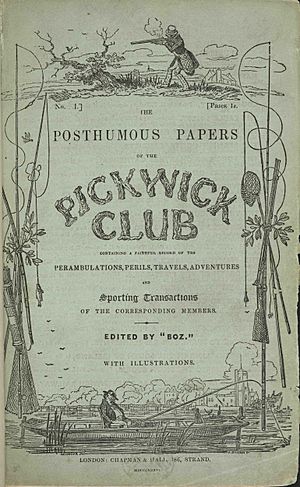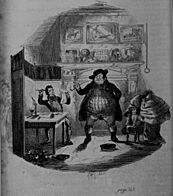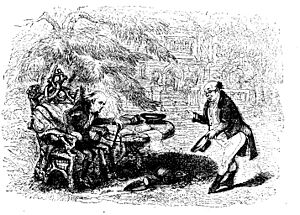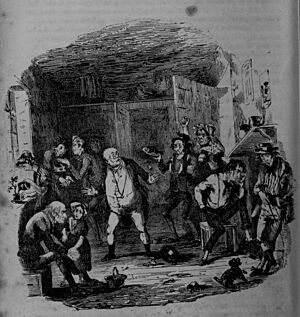The Pickwick Papers facts for kids

Original cover issued in 1836
|
|
| Author | Charles Dickens ("Boz") |
|---|---|
| Original title | The Posthumous Papers of the Pickwick Club, Containing a Faithful Record of the Perambulations, Perils, Travels, Adventures and Sporting Transactions of the Corresponding Members |
| Illustrator | Robert Seymour Robert William Buss Hablot Knight Browne (Phiz) |
| Country | England |
| Language | English |
| Subject | Travels in the English Countryside |
| Genre | Novel |
| Published | Serialised March 1836 – November 1837; book format 1837 |
| Publisher | Chapman & Hall |
| Media type | |
| Preceded by | Sketches by Boz |
| Followed by | Oliver Twist |
The Posthumous Papers of the Pickwick Club (also known as The Pickwick Papers) was the very first novel written by the famous English author Charles Dickens. Before this, he had published a collection of stories called Sketches by Boz in 1836. His publisher, Chapman & Hall, asked Dickens to write descriptions for a series of funny pictures by illustrator Robert Seymour. The idea was to connect these pictures into a novel.
This book became incredibly popular! People bought illegal copies, watched plays based on it, and even bought joke books about one of its characters, Sam Weller. It was a huge hit, showing how much people loved the story. The Pickwick Papers was released in 19 parts over 20 months. This way of publishing, called "serialised fiction," became very popular, and it also made "cliffhanger endings" (where a chapter ends on a suspenseful moment) famous.
Robert Seymour's widow later said that the idea for the novel was originally her husband's. However, Dickens strongly disagreed. In his introduction to the 1867 edition, he wrote that Mr. Seymour "never originated or suggested an incident, a phrase, or a word, to be found in the book."
Contents
How the Story Began
In 1836, Charles Dickens was 24 years old. He worked as a reporter for Parliament and also as a traveling journalist. He had already published a book of stories about life in London. The publishers, Chapman & Hall, planned a series of funny pictures about city people trying to do sports.
The idea was to have a club whose members would go on hunting and fishing trips. Funny things would happen, like their guns going off by accident or fishhooks getting caught in their hats. These funny moments were meant to be shown in Seymour's pictures. The publishers asked Dickens to write the story that would explain these pictures and link them together. Dickens said he didn't know much about sports, but he still took the job.
Dickens usually wrote his story first, and then the artist would draw pictures to match what he had written. This meant the story became the most important part, and the illustrations were secondary. Robert Seymour drew the pictures for the first two parts of the story before he sadly passed away. Robert William Buss illustrated the third part, but Dickens didn't like his work. So, the rest of the parts were illustrated by Phiz (Hablot Knight Browne), who went on to illustrate most of Dickens's later novels. The story parts were first put together into a book in 1837.
What the Story Is About
The Pickwick Papers is a collection of adventures that are loosely connected. The story takes place around 1827–1828.
The main character is Samuel Pickwick, Esquire. He is a kind and rich old gentleman who founded the Pickwick Club. He suggests that he and three other "Pickwickians" should travel to places far from London. They would then report their findings back to the other club members. Their journeys through the English countryside by coach make up most of the novel.
A misunderstanding happens between Mr. Pickwick and his landlady, the widow Mrs Bardell. This leads to a famous legal case in English literature called Bardell v. Pickwick. Because of this lawsuit, both Mr. Pickwick and Mrs. Bardell end up in the Fleet Prison for debt. Mr. Pickwick learns that the only way to help Mrs. Bardell is to pay her legal costs. This also allows him to leave prison.
Main Characters
- Samuel Pickwick – He is the main character and the person who started the Pickwick Club. He is usually shown as a kind, round-faced, clean-shaven, and somewhat plump gentleman who wears glasses.
- Nathaniel Winkle – A young friend of Mr. Pickwick and his travel buddy. He thinks he is good at sports, but he is actually quite clumsy with horses and guns.
- Augustus Snodgrass – Another young friend and companion. He believes he is a poet, but the book doesn't actually show any of his poems.
- Tracy Tupman – The third traveling friend. He is a middle-aged man who is a bit overweight but still sees himself as a romantic person.
- Sam Weller – Mr. Pickwick's personal helper. He is known for his unique sayings and helpful advice.
- Tony Weller – Sam's father, who is a talkative coachman.
- Alfred Jingle – A traveling actor who is a bit of a trickster. He tells strange stories in a very unusual, broken-up way.
Other Important Characters
- Joe – He is known as the "fat boy." Joe eats a lot of food and is always falling asleep, no matter where he is or what time it is. His constant sleeping problem led to the medical term Pickwickian syndrome, which helped describe a condition related to sleep and breathing problems in people who are overweight.
- Job Trotter – Mr. Jingle's clever servant. His true slyness is only seen briefly before he pretends to be meek and humble.
- Mr Wardle – He owns a farm in Dingley Dell and is a friend of Mr. Pickwick. Joe is his servant.
- Rachael Wardle – Mr. Wardle's unmarried sister. She tries to run away with the dishonest Jingle, but it doesn't work out.
- Mr Perker – A lawyer for Mr. Wardle, and later for Mr. Pickwick.
- Serjeant Buzfuz – The lawyer for the other side in the Bardell v. Pickwick case. He is a skilled lawyer who uses his speaking abilities to make a weak case against Mr. Pickwick seem very strong.
- Mary – A servant girl and Sam Weller's girlfriend.
- Mrs Martha Bardell – Mr. Pickwick's landlady. She is a widow who sues him.
- Emily Wardle – One of Mr. Wardle's daughters. She is very fond of Mr. Snodgrass.
- Arabella Allen – A friend of Emily Wardle and Ben Allen's sister. She later runs away with and marries Mr. Winkle.
- Benjamin "Ben" Allen – Arabella's brother. He is a medical student who likes to party too much.
- Robert "Bob" Sawyer – Ben Allen's friend and fellow student.
- Mr Stiggins (the "deputy shepherd") – A greedy and dishonest minister.
Later Stories and Adaptations
Mr. Pickwick, Sam Weller, and his father Tony appeared again briefly in 1840. This was in a magazine called Master Humphrey's Clock. This magazine was about a literary club where members read stories to each other. Mr. Pickwick was a member of this club. There was also a similar club in the kitchen, called Mr. Weller's Watch, run by Sam Weller.
The novel has been made into films, television shows, and radio plays:
- 1913 – The Pickwick Papers, a silent film.
- 1921 – The Adventures of Mr. Pickwick, another silent film.
- 1936 – The world's first televised opera, Pickwick by Albert Coates, was shown.
- 1938 – Orson Welles's Mercury Theater on the Air made a radio version.
- 1952 – The first sound film version was released.
- 1985 – An animated version was made.
In 1985, the BBC released a 12-part TV miniseries. In 1977 and 1997, BBC Radio 4 also released radio plays of the story.
There have been many stage plays and musicals based on the book. One famous musical called Pickwick opened in London in 1963. It starred Harry Secombe as Mr. Pickwick. A song from this musical, If I Ruled the World, became a big hit.
Part of The Pickwick Papers was also featured in Charles Dickens' Ghost Stories, a 60-minute animated film from 1987.
How the Book Was Published
The novel was published in 19 separate parts over 20 months. The very last part was double the usual length. Charles Dickens missed one deadline in May 1837 because he was sad after his sister-in-law, Mary Hogarth, passed away. So, no part was released that month.
Here's when each part came out:
- Part I – March 1836 (chapters 1–2)
- Part II – April 1836 (chapters 3–5)
- Part III – May 1836 (chapters 6–8)
- Part IV – June 1836 (chapters 9-11)
- Part V – July 1836 (chapters 12–14)
- Part VI – August 1836 (chapters 15–17)
- Part VII – September 1836 (chapters 18–20)
- Part VIII – October 1836 (chapters 21–23)
- Part IX – November 1836 (chapters 24–26)
- Part X – December 1836 (chapters 27–29)
- Part XI – January 1837 (chapters 30–32)
- Part XII – February 1837 (chapters 33–34)
- Part XIII – March 1837 (chapters 35–37)
- Part XIV – April 1837 (chapters 38–40)
- Part XV – June 1837 (chapters 41–43)
- Part XVI – July 1837 (chapters 44–46)
- Part XVII – August 1837 (chapters 47–49)
- Part XVIII – September 1837 (chapters 50–52)
- Part XIX-XX – October 1837 (chapters 53–57)
Where Dickens Got His Ideas
Dickens used places he knew from his own childhood in the story. For example, he set the duel between Mr. Winkle and Dr. Slammer at Fort Pitt in Chatham. This was close to where he lived as a boy between 1817 and 1821.
The Book's Impact and Legacy
The huge popularity of The Pickwick Papers led to many other books that copied or continued the story. It also inspired real-life clubs and societies, just like the club in the novel. One example is the Pickwick Bicycle Club of London, which started in 1870, the same year Charles Dickens passed away. Another, the Dickens Pickwick Club, was founded in 1976 by Cedric Charles Dickens, the author's great-grandson. Many other "Pickwick Clubs" have existed since the book was first published.
In 1837, Charles Dickens wrote to William Howison about the Edinburgh Pickwick Club. Dickens was happy that they used the name and celebrated the characters from his book. He wrote that his "heart is among you always."
In many Pickwick Clubs, members can even take on the names of characters from the novel. The Pickwick Bicycle Club's rules say that "Each Member shall adopt the sobriquet allocated by the Management Committee, being the name of some male character in the Pickwick Papers, and be addressed as such at all meetings of the Club."
One book that copied Dickens's style was Pickwick Abroad; or, The Tour in France by George W. M. Reynolds.
Translations of the Book
A French version of the book, translated by Eugénie Niboyet, came out in 1838. It was called Le Club des Pickwistes, roman comique. Later French translations used titles like Aventures de Monsieur Pickwick.
Benito Pérez Galdós published Aventuras de Pickwick, a Spanish translation, in 1868. Pérez Galdós is sometimes called the Spanish equivalent of Dickens because of his writing style.
See also
- George and Vulture
- Spaniards Inn
- The Moosepath League – These books are a tribute to The Pickwick Papers with characters similar to those in Dickens's novel.
- Wellerism






